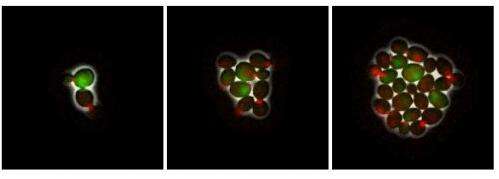Three fluorescent images of yeast cells as they grow from two single cells (left) to a small cell cluster (right). The green color represents the expression of the HO gene. The red color at the bud neck is a marker for cell cycle. Credit: Bai lab, Penn State University
(Phys.org) —By studying a gene in yeast, a team of scientists has found that modifications to histones—proteins associated with DNA—can control whether or not a gene is allowed to function and may be important in maintaining the genes' "expression potential" so that future cells behave as their parent cells did. The research was led by Lu Bai, an assistant professor of biochemistry, molecular biology, and physics at Penn State University, in collaboration with David Stillman at the University of Utah. The discovery, which may have implications for the study of diseases such as cancer, will be published in a print edition of the journal Proceedings of the National Academy of Sciences.
Bai explained that gene expression—the process by which certain genes are regulated or turned "on" or "off"—is one of the most fundamental processes in the life of any biological cell. Different programs of gene expression—even when cells have the same DNA—can lead to different cellular behavior and function. For example, even though a human muscle cell and a human nerve cell have identical DNA, they behave and function very differently. Misregulation of gene expression can affect cell fitness and lead to diseases. "Gene expression tends to vary from cell to cell," Bai said. "Misregulation may happen in a small fraction of cells, and these cells may cause disease later on. Therefore it is important to study gene regulation at the single-cell level."
Using a fluorescent video of cell division, Bai and her team were able to observe how a gene called HO was expressed in single yeast cells over multiple cell divisions. Normally, the expression of HO allows budding yeast to change sex—from "male" to "female" and vice versa. "Interestingly, HO expression—and thus sex change—is supposed to occur only in 'mother' cells but not the newly budded 'daughter' cells," Bai explained. After observing the video, team members found that HO was expressed in 98 percent of the mother cells but also in 3 percent of the daughter cells. "The vast majority of both the mother cells and the daughter cells responded as they were supposed to," Bai said. "But, in a small percentage of the cells, the gene regulation went wrong."
The pressing question for Bai's team then was, why did the HO gene regulation fail in a small population of cells—in 2 percent of the mother cells and 3 percent of the daughter cells? She discovered that the answer seems to lie in histones, a major protein complex associated with DNA. "We found that changes in histone configurations affect the fraction of cells in which the HO expression was misregulated. In addition, we found that, in some conditions, the HO expression can 'remember' itself: If HO is turned on in one cell, it is more likely to be turned on in its progeny cells. We showed that this short-term memory of the HO expression seems to be inherited through histone modifications," Bai said. She added that further study of gene expression, specifically at the level of individual cells, can have important implications for disease research.
Journal information: Proceedings of the National Academy of Sciences
Provided by Pennsylvania State University





















